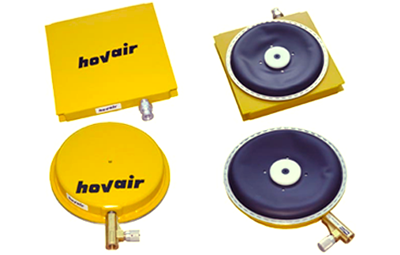Traditional material handling methods that rely on wheels, rollers, or tracks involve manual labor and heavy lifting, which can lead to inefficiencies, safety risks, and product damage. However, air skids offer a modern and innovative solution to these challenges.
What are Air Skids
Air skids, also known as air casters or air bearings, are devices designed to facilitate the movement of heavy loads with minimal friction. They utilize compressed air to create a thin film of air between the load and the floor, enabling smooth and precise movement.
Air skids consist of durable air cushions or bearings that distribute the load evenly and provide stable support, allowing heavy, large, or irregularly shaped objects to move effortlessly with minimal force, eliminating manual pushing or pulling.
These devices are commonly used in various industries for material handling applications, such as moving machinery, equipment, and large components in manufacturing, logistics, aerospace, automotive, and other sectors.
The Case for Smooth and Precise Positioning
Air skids offer precise positioning capabilities, allowing operators to place heavy loads with pinpoint accuracy.
By controlling the compressed air flow to the skids, operators can adjust the speed and direction of movement, enabling smooth and controlled positioning of the load. This level of precision is particularly beneficial in manufacturing, assembly, and installation applications where accurate alignment and placement are critical.
With air skids, operators can achieve precise positioning without requiring complex lifting and rigging equipment or manual adjustments, saving time and improving overall productivity.
Advantages of Air Skids
Safety and Ergonomics
Safety is a top priority in any industrial environment, and air skids contribute to a safer workplace by reducing the risk of manual handling injuries and accidents.
By eliminating the need for heavy lifting and manual pushing or pulling, air skids help mitigate the physical strain and fatigue associated with traditional material handling methods. This not only protects workers from potential injuries but also enhances overall workplace ergonomics and employee well-being.
With air skids, operators can move heavy loads safely and efficiently, minimizing the risk of accidents and improving workplace morale.
Reduced Floor Damage
Traditional material handling equipment can cause damage to floors, particularly in sensitive environments such as cleanrooms or warehouses with epoxy-coated surfaces.
In contrast, air skids exert minimal pressure on the floor due to their frictionless movement, reducing the risk of floor damage and minimizing downtime associated with repairs or replacements. This is especially important in facilities where maintaining a clean and pristine environment is essential for product quality and regulatory compliance.
Increased Efficiency and Productivity
With faster load movement and precise positioning capabilities, air skids streamline material handling processes, reduce cycle times, and optimize workflow efficiency. This allows organizations to maximize throughput, meet production targets, and respond quickly to changing customer demands.

Whether used for production line operations, assembly processes, or facility reconfigurations, air skids help organizations achieve higher levels of efficiency and productivity, ultimately driving business success.
Cost Savings
In addition to improving efficiency and productivity, air skids offer cost-saving benefits that contribute to the bottom line. By reducing the need for manual labor, minimizing floor damage, and enhancing workplace safety, air skids help organizations lower operational costs and improve overall profitability.
With their ability to deliver significant cost savings and operational efficiencies, air skids represent a valuable investment for organizations seeking to optimize their material handling processes.
Ready to experience the transformative benefits of air skids for your material handling operations? Call 1-800-237-4518 to schedule a product demonstration.
